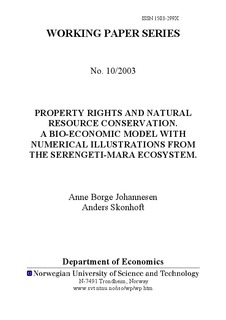| dc.contributor.author | Johannesen, Anne B. | nb_NO |
| dc.contributor.author | Skonhoft, Anders | nb_NO |
| dc.date.accessioned | 2014-12-19T14:31:53Z | |
| dc.date.available | 2014-12-19T14:31:53Z | |
| dc.date.created | 2006-10-05 | nb_NO |
| dc.date.issued | 2003 | nb_NO |
| dc.identifier | 126103 | nb_NO |
| dc.identifier.uri | http://hdl.handle.net/11250/267137 | |
| dc.description.abstract | This study develops a model for wildlife migrating seasonally between a conservation area and a neighbouring area. When being outside the conservation area, harvesting takes place by a group of small-scale farmers. The local people have two motives for harvesting; to get rid of 'problem' animals as roaming wildlife destroys crops and agricultural products, and hunting for meat and trophies. Depending on the specification of the property rights, the harvesting is legal or illegal. It is demonstrated that it is far from clear which of the two property rights regimes that gives the highest wildlife abundance. Hence, contrary to what is argued for in the literature, handing the property rights over to the local people means not automatically more wildlife and a more 'sustainable' resource utilization. The reason lies in the nuisance motive for harvesting. The exploitation under the two different property rights regimes are illustrated by numerical calculations with data that fits reasonable well with the exploitation of the wildebeest population in the Serengeti-Mara ecosystem. | nb_NO |
| dc.language | eng | nb_NO |
| dc.publisher | Institutt for samfunnsøkonomi | nb_NO |
| dc.relation.ispartofseries | Working Paper Series, 1503-299X; 2003:10 | nb_NO |
| dc.title | Property Rights and Natural Resource Conservation: A Bio-Economic Model with Numerical Illustrations from the Serengeti-Mara Ecosystem | nb_NO |
| dc.type | Research report | nb_NO |
| dc.contributor.department | Norges teknisk-naturvitenskapelige universitet, Fakultet for samfunnsvitenskap og teknologiledelse, Institutt for samfunnsøkonomi | nb_NO |
